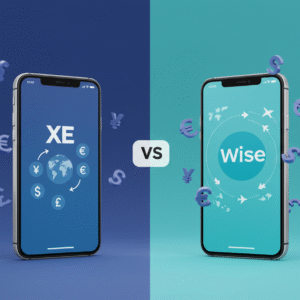This article may contain references to products or services from one or more of our advertisers or partners. We may receive compensation when you click on links to those products or services. Nonetheless, our opinions are our own.
The information presented in this article is accurate to the best of our knowledge at the time of publication. However, information is subject to change, and no guarantees are made about the continued accuracy or completeness of this content after its publication date.
What Is an Index Fund?
An index fund is a type of investment vehicle, either a mutual fund or an exchange-traded fund (ETF), that seeks to mirror the performance of a specific market index, such as the S&P 500 or the Nasdaq-100. Instead of selecting individual stocks to try and outperform the market, index funds adopt a passive strategy: they aim to replicate the holdings and returns of a broad market benchmark. This approach makes index funds an appealing option for those who prefer a simplified, lower-cost investment strategy. By tracking an index, these funds typically offer broad exposure to the market and reduce the risks associated with holding individual securities.
How Index Funds Operate
Index funds function by purchasing the same securities found in the index they are designed to follow. For example, a fund tracking the S&P 500 will hold shares of the 500 companies listed in that index, weighted according to their market capitalization. This passive replication model helps the fund closely track the index’s performance. Because it requires less research and fewer trades than active management, it significantly reduces operating costs, which can enhance long-term investment returns.
Advantages of Index Funds
Lower Costs
One of the most notable features of index funds is their cost-efficiency. These funds typically carry lower expense ratios because they are not actively managed. Investors retain a larger portion of their earnings over time due to fewer management fees and lower trading costs.
Built-in Diversification
By tracking a broad index, these funds automatically invest across a wide range of companies, sectors, or asset classes. This built-in diversification helps cushion the impact of poor performance from any single stock, reducing overall portfolio volatility.
Predictable Market Exposure
Since index funds aim to match the market, their performance generally reflects the broader economy. Over extended periods, this can result in steady, dependable growth aligned with general market trends.
Voted "Best Overall Budgeting App" by Forbes and WSJ
Monarch Money helps you budget, track spending, set goals, and plan your financial future—all in one app.
Get 50% OFF your first year with code MONARCHVIP
Comparing Long-Term Costs
Over decades of investing, even minor differences in fees can significantly impact portfolio growth. Because index funds generally engage in fewer transactions and require less oversight, their fees are considerably lower than those of actively managed counterparts.
Illustrative Cost Savings
| Fund Type | Average Annual Expense Ratio | Estimated 30-Year Savings |
|---|---|---|
| Index Fund | 0.1%–0.5% | $20,000+ |
| Actively Managed Fund | 1.0%–2.0% | $40,000+ |
These figures demonstrate how minimizing costs contributes meaningfully to long-term returns.
Portfolio Simplicity and Balance
Streamlined Investment Strategy
Index funds offer a simplified way to maintain balance across sectors without the need for constant oversight. This allows investors to build a diversified portfolio through a single investment instrument, reducing the complexity involved in selecting and managing individual stocks.
Risk Distribution
Because index funds are composed of multiple securities, they distribute risk across a broad range of holdings. This feature is especially beneficial for conservative investors seeking stability.
Choosing an Index Fund
 When evaluating an index fund, several attributes should be considered to ensure alignment with investment goals.
When evaluating an index fund, several attributes should be considered to ensure alignment with investment goals.
Expense Ratio
Lower expenses leave more capital invested. Aim for funds with a consistently low expense ratio, ideally below 0.2% where possible.
Tracking Error
This metric indicates how closely a fund mirrors its index. A smaller tracking error reflects more accurate replication of index performance.
Dividend Yield
For income-focused portfolios, review a fund’s dividend yield and distribution schedule.
Addressing Common Misunderstandings
Misconception: Index Funds Are Only for Passive Investors
While index funds follow a passive investment model, they can also serve as a core component within more dynamic strategies. Investors often combine them with tactical allocations to specific sectors or individual stocks.
Misconception: They Are Only for the Long Term
Although suited for long-term goals, index funds can also meet intermediate or short-term objectives. Their flexibility makes them a suitable option across various time horizons.
Performance Snapshot Over Time
| Time Frame | Index Fund Avg. Return | Active Fund Avg. Return |
|---|---|---|
| 1 Year | 10% | 6% |
| 5 Years | 50% | 40% |
| 10 Years | 120% | 80% |
Consistent returns and lower volatility help explain the growing popularity of index funds, especially among retirement and long-horizon investors.
Frequently Asked Questions
What does an index fund invest in?
An index fund holds a representative sample of the securities in a market index, proportionally based on the index’s structure.
Are index funds safe?
No investment is entirely without risk. However, index funds are considered relatively lower risk due to diversification and market alignment.
Can they outperform the market?
No. By design, index funds aim to match the market, not outperform it. That said, they often outperform many actively managed funds after fees are accounted for.
How does one start investing in index funds?
They are widely available through most brokerage platforms and retirement accounts. Investors can begin with a lump sum or set up recurring contributions.
What are the downsides?
Index funds do not shield investors from market downturns.

Reviewed and edited by Albert Fang.
See a typo or want to suggest an edit/revision to the content? Use the contact us form to provide feedback.
At FangWallet, we value editorial integrity and open collaboration in curating quality content for readers to enjoy. Much appreciated for the assist.
Did you like our article and find it insightful? We encourage sharing the article link with family and friends to benefit as well - better yet, sharing on social media. Thank you for the support! 🍉
Article Title: What’s a Ponzi Scheme? The Basics and Its Risks
https://fangwallet.com/2025/06/07/whats-a-ponzi-scheme/The FangWallet Promise
FangWallet is an editorially independent resource - founded on breaking down challenging financial concepts for anyone to understand since 2014. While we adhere to editorial integrity, note that this post may contain references to products from our partners.
The FangWallet promise is always to have your best interest in mind and be transparent and honest about the financial picture.
Become an Insider

Subscribe to get a free daily budget planner printable to help get your money on track!
Make passive money the right way. No spam.
Editorial Disclaimer: The editorial content on this page is not provided by any of the companies mentioned. The opinions expressed here are the author's alone.
The content of this website is for informational purposes only and does not represent investment advice, or an offer or solicitation to buy or sell any security, investment, or product. Investors are encouraged to do their own due diligence, and, if necessary, consult professional advising before making any investment decisions. Investing involves a high degree of risk, and financial losses may occur including the potential loss of principal.
Source Citation References:
+ Inspo
There are no additional citations or references to note for this article at this time.












































